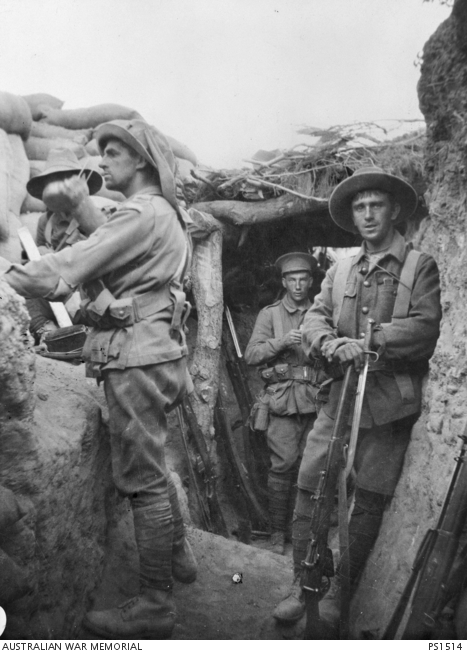
This is one of my favourite images to use with students of all ages when talking about the First World War. It tells stories of life in the trenches, particularly at Gallipoli, as well the horror of combat. It also provides for a multi sensory and interdisciplinary approach. Depending on the age of the students and their prior knowledge, here are some things to explore.
Where is this photo taken? With just the date, 6 August 1915, students can deduce that the photo was taken at Gallipoli, where the large majority of Australians were in 1915. Additional knowledge with deduce that the photo is taken during the August offensive.
Climate: By knowing the image was taken at Gallipoli on 6 August 1915, students can use their Geography skills to determine the weather at the time. August 6 in the northern hemisphere is the height of summer yet the men are wearing large wooly coats, pants and boots. How would the men feel? How would they smell?
Equipment and Uniform: Allowing the students to find and identify all of the equipment in the photo can be a drawn out task. The .303 rifle, which was standard issue to Australians will inevitably the first thing they identify. Next will be the ‘sword’ which lends itself to discussions about supply of ammunition and the need for hand to hand combat at Gallipoli, including Albert Jacka in the action for which he was awarded his Victoria Cross (VC) in May. The Pattern 08 webbing ( the pack worn over their shoulders) shows where ammunition is kept and carried and can be used to discuss how men were typically restricted to what they could carry. The webbing can also be compared that worn in the landings. This image shows the lighter battle version. Detailed image on the webbing can be found at http://www.lawranceordnance.com/information/manuals/equipment/we08.pdf The photo also shows the famous trench periscope invented by Australians and the mess tin; both to the left. You may also like to discuss the flap on the back of the slouch hat, which may be to ward off flies and research the difference between the slouch hat and the peaked cap.
Trench Life: Men did not spend their entire war either confined to the trenches or charging across no man’s land. However they could spend long periods of time in a trench. I like to encourage student to document everything they do in a week and after a bit of prompting they usually come up with a comprehensive list. Now apply the list to the trench. Discuss. Common topics include hygiene, communication, entertainment (or boredom) and food.
Combat: This image is taken in the midst of the Lone Pine battle, the men in this photo have recently captured this trench from the Turks. What have these men seen? What do they continue to hear around them as the battle continues for two more days? What might they be thinking or feeling in the trench? There is a lot of information available on the Battle of Lone Pine including the awarding of VCs.
Commemoration of Lone Pine: The Lone Pine tree is one of the well known symbols of commemoration in Australia. The name lends itself to discussions about mapping and identification in war. Lone Pine was so named for the single pine tree nearby. Without a strong relationship, the Allies knew little, if any, of the Turkish titles for locations on the peninsula, thus naming them after their leaders (Monash Valley), obvious identifiers (Lone Pine) or their similarity to well known landmarks at home or around the world (The Sphinx). Further to this, the Turks adopted the name Anzac Cove for the Anzacs landing site following the war, allowing students to explore Australia’s relationship with the Turks in the decades after the war. Students can also conduct their own service at a local lone pine tree, they may even like to research people who served at Lone Pine beforehand. If you do not have a Lone Pine, they are available to purchase.
Many images allow for such an indepth discussion of the Australian experience of war and other photos lend themselves or further support these discussions. This is simply the one that I have found most useful for my work. I have also been fortunate, in many cases, to have had the webbing, tunic and slouch hat to further complement my discussion. Many museums, RSLs and historical societies have originals/replicas on display or for exploration as part of education programs. The Australian War Memorial and its affiliates also have boxes that can be loaned to schools which contain artefacts and replicas of a military history items.

